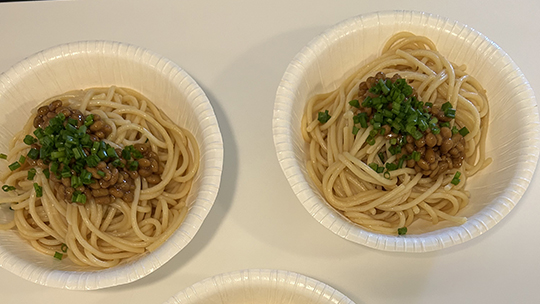For some, natto is a delicious staple. For others, it’s slimy, mysterious, and potentially off-putting. There’s usually no middle ground.
Natto is made of fermented soybeans. It’s thought to have originated in Japan nearly a thousand years ago. Natto even made an appearance in a newly released television show based on a novel that takes place in Japan in 1600. Are you tuning into that show, too? Here's what to know about natto.
Food facts
According to the U.S. Department of Agriculture, natto contains 19.4 grams of protein in a 100-gram serving. In contrast, kidney beans contain 7.8 grams of protein per 100-gram serving.
Natto is a source of micronutrients (vitamins and minerals), such as manganese and iron.
Manganese helps the body break down carbohydrates, proteins, and cholesterol. Iron supports metabolism, immunity, and helps to transport oxygen to the body’s tissue and muscles. Natto is also one of the top food sources of vitamin K, which plays a role in blood clotting and bone health.
How it’s made
Natto is made by washing, soaking, steaming, and adding a probiotic strain to the soybeans. The soybeans are then packaged and fermented for about 18 hours. Get an inside look at natto production in a Japanese factory.
How to eat it
There are many ways to enjoy natto. Here are a few of our favorites:
- On rice. Add the shoyu and/or mustard packet that comes with store-bought natto, mix together, and add the natto mixture on a hot bed of rice. It can also be enjoyed with green onions, an egg prepared your favorite way, and with a drizzle of sesame oil. If you know, you know.
- On toast. Take two slices of bread, toast them, add your natto mixture, top with Monterey jack cheese, broil to finish. Read more about this method.
- On pasta. Prepare and drain spaghetti or preferred pasta, add a tablespoon of butter and shoyu to taste (or butter, miso, and a splash of half and half), add natto, top with chives.

Did you know?
Natto Day is celebrated on July 10, which falls on a Wednesday this year. “Na” is an abbreviation for nana in Japanese, which means seven, and “tou” is one of the ways the number 10 can be read in Japanese. Hawaii restaurants may offer natto specials on July 10.
Hungry for more?
Check out these tasty recipes:
healthier fried noodles
Here’s a take on the Manapua Man’s fried noodles that we call “healthier” because we bake the noodles instead of frying them in oil. Plus, we added lots of veggies to help balance the carbs.
portuguese bean soup
Craig DeSilva shares his recipe for Portuguese bean soup (no need wait for Punahou Carnival).
eat pono’s tabouli with tricolor quinoa
Try this simple, fresh side dish that can be prepared in about 30 minutes.
veggie fries
Got veggies? Make fries with parsnips, Okinawan sweet potato, taro, and more.
oven-broiled shishito peppers
Did you know that one in 10 shishito peppers is spicy? Try this delicious recipe for an izakaya feel at home.
potato spinach frittata
Consider this a basic frittata recipe that’s subject to your whims, preferences, and ingredients you already have on hand.
ultimate keto bread
Cutting carbs or trying the ketogenic diet? Try this recipe for low-carb bread that doesn’t compromise on flavor.
curry zucchini soup
Curl up with a bowl of soup made with zucchini, garlic, and thyme.
mediterranean baked opah
The Mediterranean Diet is good for heart and brain health, diabetes prevention and control, and weight loss. This recipe features opah, a.k.a. moonfish, a tender white-flesh fish.




